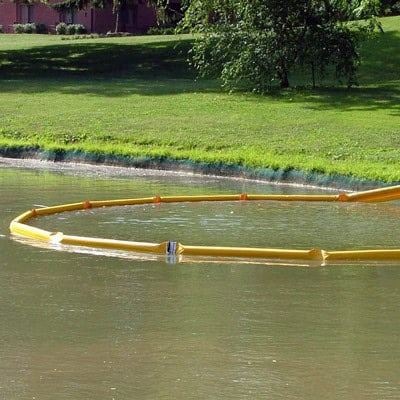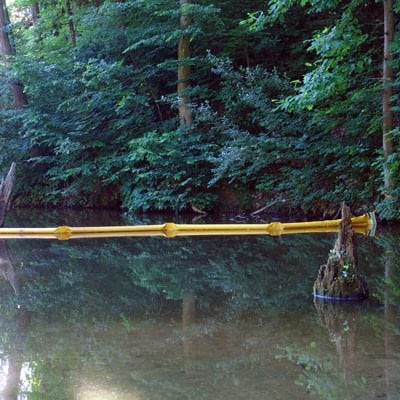In the battle against water pollution, one of the most effective tools at our disposal is the water containment boom. These booms are essential in managing and mitigating the damage from oil spills and other types of water contamination. In this article, we will explore what water containment booms are, how they work, and why they are critical in protecting our waterways.
What Are Water Containment Booms?
Water containment booms are floating barriers used to contain and control the spread of contaminants like oil on the surface of water. They are designed to block and confine spills, preventing them from spreading further into the environment. Booms are commonly used in oceans, rivers, lakes, and other bodies of water where oil spills or other hazardous substances may occur.

Types of Water Containment Booms
There are several types of water containment booms, each designed for specific conditions and types of spills. The most common types include:
- Hard Boom: Made from solid materials like plastic or metal, hard booms are used in calm waters. They are robust and can withstand harsh conditions but are less flexible.
- Inflatable Boom: These booms can be inflated with air or water and are suitable for various water conditions. They are easy to deploy and store, making them ideal for emergency response.
- Fire Boom: Designed for oil spills that can be burned off, fire booms are made of fire-resistant materials. They contain the oil while it burns, preventing it from spreading.
- Sorbent Boom: These booms are filled with materials that absorb oil and other liquids. They are particularly useful for small spills and in shallow waters.
How Do Water Containment Booms Work?
Water containment booms work by creating a physical barrier on the water’s surface. Here’s how they function:
- Deployment: Booms are deployed around the perimeter of a spill. Depending on the type and location of the spill, they can be anchored to the shore, a vessel, or left to float freely.
- Containment: Once in place, the boom prevents the spill from spreading further. It traps the contaminant within a confined area, making it easier to collect and remove.
- Collection: After containment, the trapped oil or pollutant is collected using skimmers, vacuums, or absorbent materials. The collected substance is then safely disposed of or treated.
- Removal: Once the cleanup is complete, the booms are carefully removed and cleaned for future use.
Factors Affecting Boom Effectiveness
The effectiveness of a water containment boom can be influenced by several factors, including:
- Weather Conditions: High winds, strong currents, and rough seas can reduce boom effectiveness by pushing or breaking them apart.
- Boom Material: The type of material used can affect the boom’s durability and ability to contain spills. For example, inflatable booms are more flexible but less durable than hard booms.
- Spill Type: Different types of spills require different boom designs. For instance, a thick oil spill may require a more robust boom than a thin layer of light oil.
Why Are Water Containment Booms Important?
Water containment booms play a vital role in environmental protection and pollution management. Here are some reasons why they are important:
Environmental Protection
Booms help protect marine and coastal ecosystems by preventing harmful substances from spreading. This protection is crucial for preserving wildlife habitats and maintaining biodiversity.
Economic Impact
Oil spills and water contamination can have severe economic consequences for industries like fishing, tourism, and shipping. By containing spills quickly, booms help minimize these impacts and reduce cleanup costs.
Emergency Response
In the event of an oil spill or chemical leak, rapid response is essential to minimize damage. Water containment booms allow responders to act quickly and efficiently, preventing further environmental harm.
Versatility
Water containment booms are adaptable and can be used in various environments and conditions. Whether in open oceans or small lakes, booms provide a flexible solution for managing spills.

Real-World Applications of Water Containment Booms
Water containment booms have been used in numerous high-profile oil spills and environmental disasters. Some notable examples include:
Deepwater Horizon Oil Spill
During the Deepwater Horizon oil spill in 2010, containment booms were deployed extensively to control the spread of oil in the Gulf of Mexico. They played a critical role in limiting environmental damage and aiding the cleanup efforts.
Exxon Valdez Oil Spill
In the aftermath of the Exxon Valdez oil spill in 1989, containment booms were used to contain the spill and protect the Alaskan coastline. The incident highlighted the importance of having effective containment measures in place.
Conclusion
Water containment booms are an indispensable tool in the fight against water pollution. Their ability to contain and control spills makes them essential for protecting our environment and minimizing the economic impact of water contamination. By understanding how they work and why they are important, we can better appreciate the role they play in safeguarding our planet’s waterways.
As we continue to face environmental challenges, the use of water containment booms will remain a critical component of our pollution response strategies, ensuring that we can quickly and effectively address spills and protect our precious natural resources.
Shop Water Containment Booms at Absorbents Online
Looking to enhance your spill response strategy with reliable water containment solutions? Shop our selection of high-quality water containment booms at Absorbents Online. Our booms are designed to offer maximum protection and efficiency when managing hazardous spills. Whether you’re dealing with oil, chemicals, or other pollutants, our booms provide a robust and adaptable solution tailored for various environments. Visit Absorbents Online today to explore our comprehensive range, and ensure you’re equipped to protect both your operations and the environment effectively.